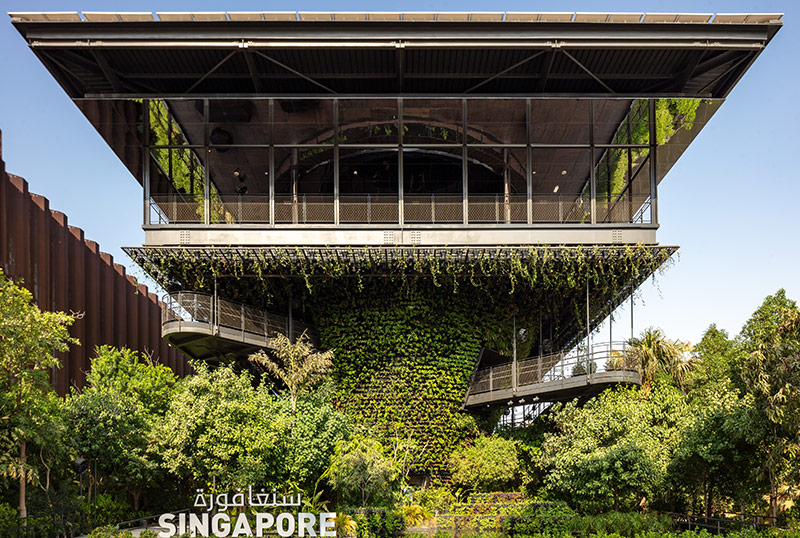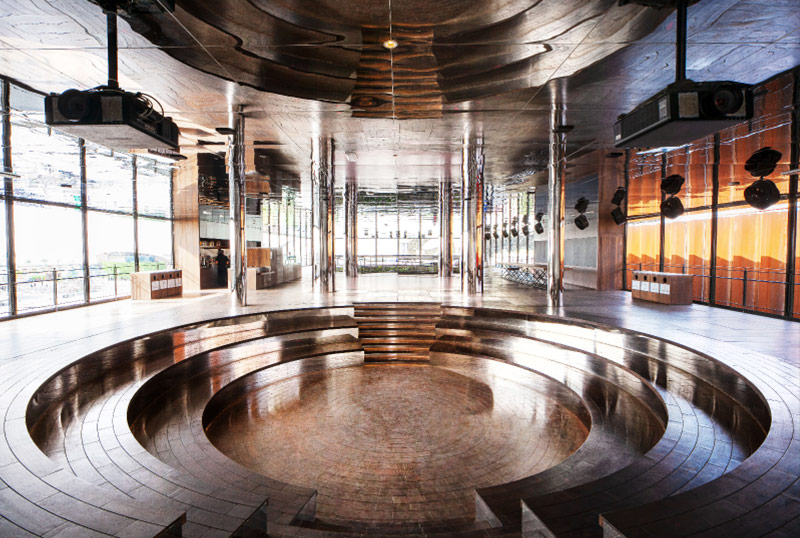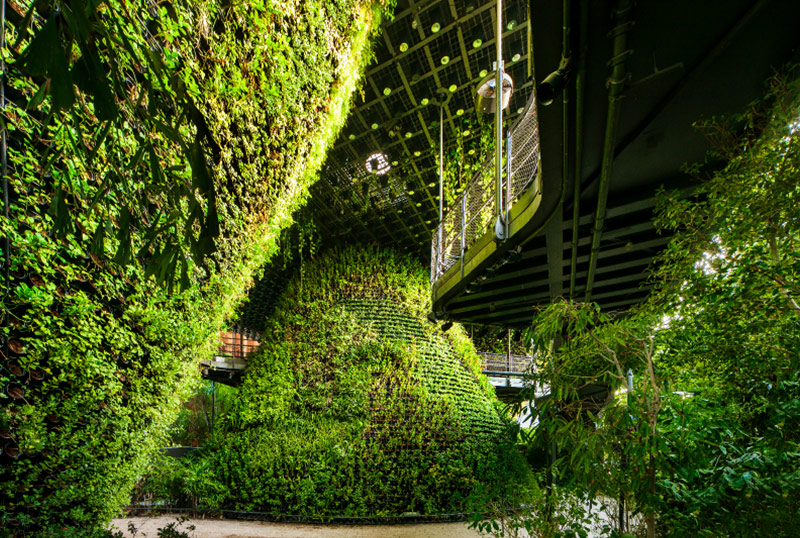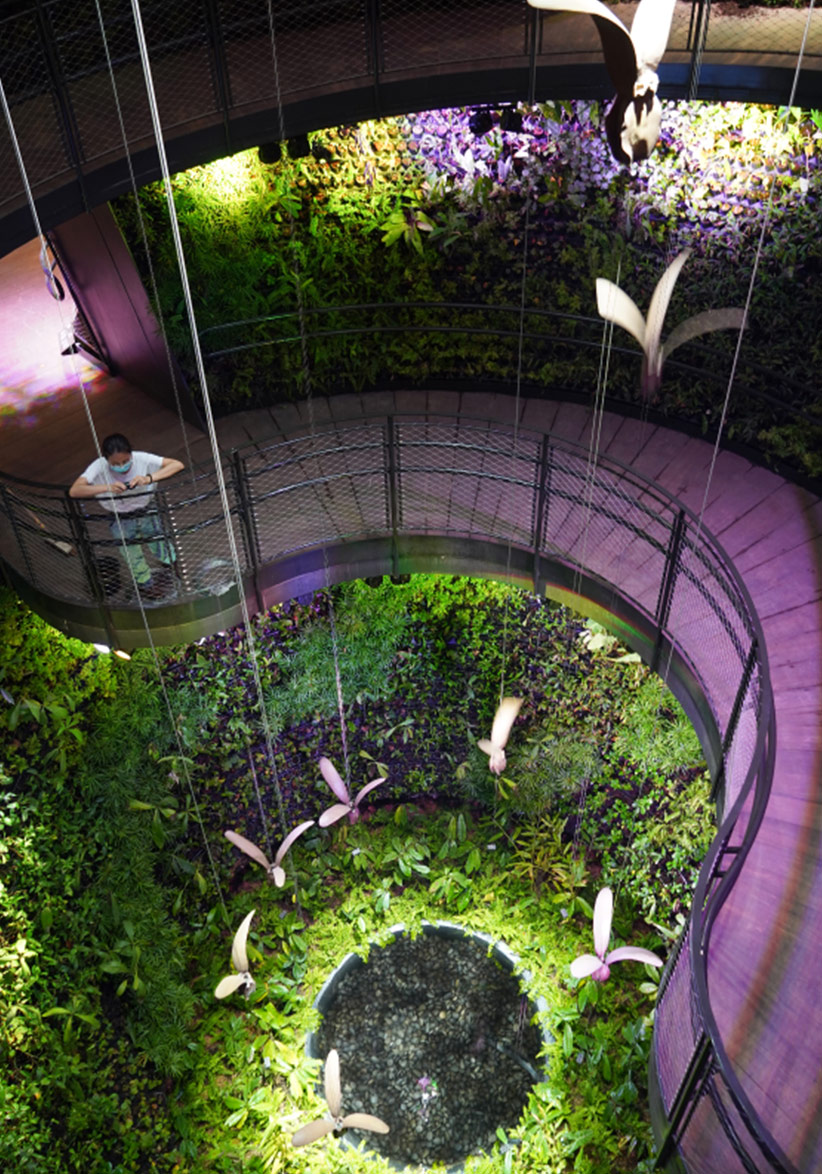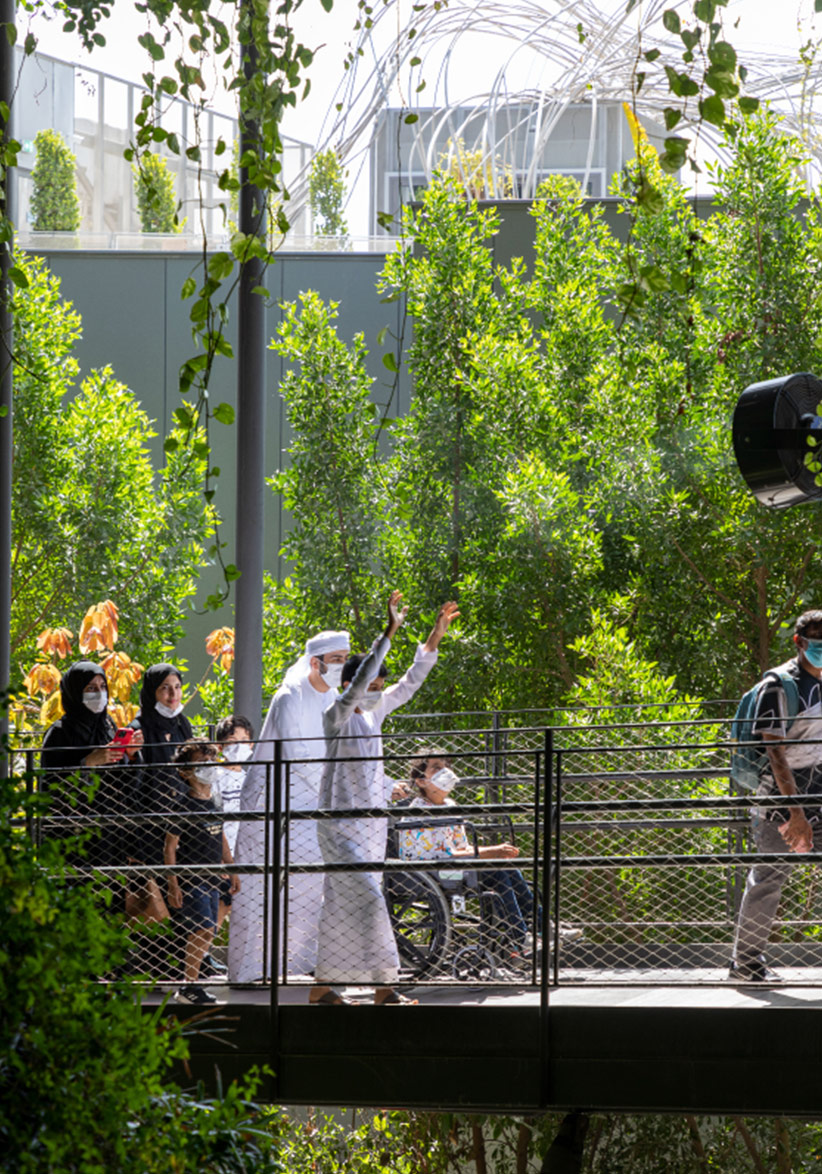* DESIGN OF
THE YEAR 2023
Singapore Pavilion, Expo 2020 Dubai
Designer
WOHA Architects Pte Ltd
DISCIPLINE
Architecture
DESIGN IMPACT
Advancing Singapore Brand, Culture and Community
Enabling Economic Transformation
Making Ground-breaking Achievements in Design
Raising Quality of Life
CONTACT
sight and welcome relief to visitors from around the world. This was the Singapore Pavilion at the World Expo held in Dubai – a showcase of how nature and architecture can co-exist to create a sustainable and liveable city.
WOHA Architects designed the compact pavilion interwoven with a garden taking inspiration from the theme Nature. Nurture. Future. The ground floor’s verdant display of palms, trees, shrubs, and orchids extended into the pavilion structure,
including a spectacular “Hanging Garden” on the ceiling. Anchoring the structure were three “cones” that each showcased one aspect of the theme. Together, a passage of walkways and ramps took visitors through an immersive green canopy that culminated with a “Sky Market” offering a slice of Singapore culture, ranging from talks and films to food.
The pavilion was self-sufficient by design. A solar roof shaded visitors and the plants, while obtaining clean energy from the sun to power various technologies, including a desalination system that provided water for the greenery and mist fans for cooling. The seamless integration of nature, architecture, and technology created a biophilic environment that reduced heat and pollutants, sequestered greenhouse gases, and even became a habitat for wildlife. During its six months of operation from October 2021 to March 2022, the pavilion not only demonstrated how buildings and cities can be designed for regeneration, but also how the world can be made a better place for people and nature.
READ MOREABOUT THE DESIGNER
WOHA Architects is a Singapore-based practice focused on researching and innovating integrated architectural and urban solutions to tackle the problems of the 21st century such as climate change, population growth, and rapidly increasing urbanisation.
With every project, the practice creates living systems that connect to the city. They aim to be a matrix of interconnected human-scaled environments that foster community, enable stewardship of nature, generate biocentric beauty, activate ecosystem services, and build resilience. This is achieved by applying WOHA’s systems-thinking approach, which recognises how each development interacts with other systems that it is part of, and works across disciplines to achieve an integrated outcome.
Ar. Wong Mun Summ co-founded WOHA in 1994 with Ar. Richard Hassell. Wong teaches at his alma mater, the National University of Singapore’s Department of Architecture, and has also been appointed to the Seidler Chair in the Practice of Architecture at the University of New South Wales in Sydney, Australia. He sits on various design advisory panels in Singapore and around the world, including the Nominating Committee of the Lee Kuan Yew World City Prize.
Ar. Phua Hong Wei is a Director at WOHA who has worked on a variety of its projects, notably Kampung Admiralty, Oasia Hotel Downtown, Enabling Village, and Pan Pacific Orchard Hotel.
Shefali Lal is an architectural designer at WOHA. She is heavily invested in the research and development of WOHA’s ideas for future cities through her work on visionary masterplans such as Singapore 2100.
READ MORESINGAPORE ARCHITECT FIRM
WOHA Architects Pte Ltd
STRUCTURAL CONSULTANTS
Web Structures Pte Ltd
ASG Engineering Consultants
LIGHTING CONSULTANT
Light Collab LLP
PROJECT MANAGER
Radius Experiential International
CLIENT
Urban Redevelopment Authority
LANDSCAPE ARCHITECT
SALD Pte Ltd (Salad Dressing)
ENVIRONMENTALLY SUSTAINABLE DESIGN CONSULTANT
Transsolar Energietechnik GmbH
MECHANICAL & ENGINEERING CONSULTANT
CKR Consulting Engineers
BUILDER
Evan-Lim Penta Construction Co. LLC
Insights from the Recipient
Citation
Jury Citation
With its seamless integration of nature, technology, and the built environment, the Singapore Pavilion, Expo 2020 Dubai not only amplifies Singapore’s position as a sustainable and green city, but it also serves as a prototype for how sustainable built environments could be designed for future cities.
Titled Nature. Nurture. Future., the pavilion was designed as a self-contained and self-sufficient system with a net-zero energy target, where architecture, structure, and landscape are integrated to work together as a green, living ecosystem. These elements reflect Singapore’s vision of becoming a City in Nature and its journey towards growth, sustainability, and resilience.
Moving through the pavilion, visitors could immerse themselves in a microcosm of Singapore’s lush and tropical landscape. Its multi-layered greenery and use of technology supported a conducive environment for biodiversity and a memorable experience for visitors.
The Jury recognises the significance of the pavilion as a testbed and prototype in inspiring future innovative solutions to create more responsible and regenerative built environments.
VIEW JURORSNominator Citation
Dr Hossein Rezai
Global Design Director, Ramboll
Founding Director, Web Structures
WOHA’s design for the Singapore Pavilion at Expo 2020 Dubai announces the maturity of our architecture to a truly international audience.
The architecture is simple, the procession is effective, the structure is integrated, the landscape is fused into the overall design, and the whole building manifests itself as a holistic system. It delivers a desired level of performance that no single part can deliver on its own – the true definition of a “system” at work.
The pavilion occupies a rectangular site of 62 m by 25 m in the vicinity of the Sustainability Pavilion. The actual site coverage is about 50 m by 20 m. The pavilion consists of five main levels including a partial single-storey basement. The superstructure is conceived as a bold expression of the base architecture. Three cone-like elements are arranged linearly along the centreline of the site to invite visitors in.
The three cones are “capped” at the top with the “marketplace floor”, which is reached via a series of ramps and walkways running through the cones at mid-height level where the exhibits are found. A dramatic tree-top experience is created as one walks through the ramps and walkways throughout the pavilion before continuing to ascend and emerge into the marketplace level via a coiled spiral within Cone 1.
The Singapore Pavilion is a true oasis in the desert that is the current state of our built environment. It signifies the possibilities that a regenerative architecture can offer to the environmental challenges we face. It puts Singapore on the map of meaningful solutions to these challenges and gives us all cause for celebration in an otherwise arid landscape.
The design and its typology deserve recognition. I have no hesitation in recommending the building for the coveted President*s Design Award Design of the Year 2023.
